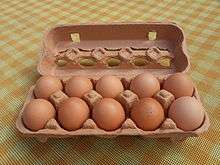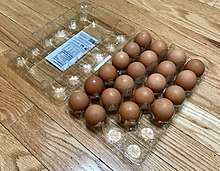Egg carton
An egg carton (also known as an egg box in British English) is a carton designed for carrying and transporting whole eggs.[1]


Description
These cartons have a dimpled form in which each dimple accommodates an individual egg and isolates that egg from eggs in adjacent dimples. This structure helps protect eggs against stresses exerted during transportation and storage by absorbing a lot of shock and limiting the incidents of fracture to the fragile egg shells.[2][3] An egg carton can be made of various materials, including foamed plastics such as polystyrene foam, clear plastic or may be manufactured from recycled paper and molded pulp by means of a mechanized papier-mâché process.[1]
Origins
Before its invention, eggs were carried in egg baskets.[1] In 1906, Thomas Peter Bethell of Liverpool invented a predecessor to the modern egg box and marketed it as the Raylite Egg Box. He created frames of interlocking strips of cardboard, and packed these frames in cardboard or wooden boxes for transport by road or rail.[4]
In 1911, newspaper editor Joseph Coyle of Smithers, British Columbia invented the egg carton, to solve a dispute between a local farmer and hotel owner in Aldermere, near present-day Telkwa, in British Columbia,[5] over the farmer's eggs' often being delivered broken.
In 1921, Morris Koppelman patented a more modern version of the egg carton.[6]
In 1969, the United Industrial Syndicate (UIS) in Maine (a division of The Portland Company) patented the modern egg carton. The three inventors listed on the filing are Walter H. Howarth, Gerald A. Snow, and Harold A. Doughty.[7]
Unlike many products, trademarks and advertisements for egg brands are usually printed on the food container itself rather than on a separate container (as with breakfast cereals).[1] This single-layer, distinctive packaging distinguishes among egg cartons from different producers or levels of quality on the retail shelf.
Sizes
Standard egg cartons have room for 10 or 12 eggs, but they can come in a variety of sizes, holding from three to 24 eggs.
Trays are usually used to store fresh eggs from farms or at farmers' markets. Plastic egg trays are also used by egg processors to wash and sanitize eggs. A cardboard sleeve or additional trays are used to protect eggs when using a tray format.
References
- Marsh, Calum (March 28, 2018). "Egg Week: An ode to the egg carton, an unassuming example of perfect design". National Post. Retrieved 2019-01-15.
- Nethercone, C H (1974). "Egg carton tests". Poultry Science. 53 (1): 311–325. CiteSeerX 10.1.1.948.6443. doi:10.3382/ps.0530311.
- Seydim, A C (1999). "Packaging Effects on Shell Egg Breakage Rates During Simulated Transportation". Poultry Science. 78 (1): 148–151. doi:10.1093/ps/78.1.148. PMID 10023763.
- Bethell, Thomas Peter. "Patent GB190606248". worldwide.
- "B.C. inventor created better way to carry eggs". Globe and Mail.
- Koppelman, Morris (June 23, 1925), Container for eggs or the like
- A, Doughty Harold; H, Howarth Walter; A, Snow Gerald (Jul 29, 1969), Egg cartons
External links
| Wikimedia Commons has media related to Egg containers. |
- Hiway 16 Magazine about the invention of the egg carton at the Wayback Machine (archive index)
- Brodrene Hartmann’s Egg Carton Production Facility, Missouri. Packaging Gateway.
- Canada Patent Page